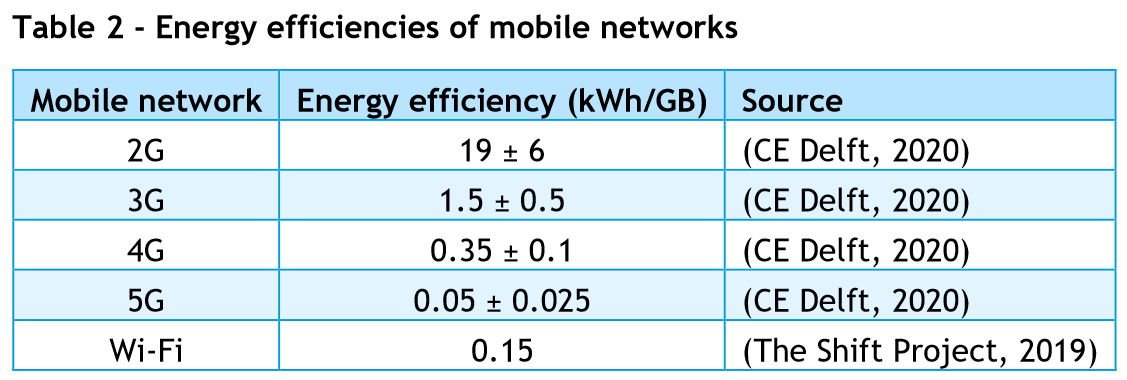Carbon footprint of unwanted data-use by smartphones
Status:: 🟩
Links:: Energy consumption of network communication
Metadata
Authors:: Uijttewaal, Meis; Bergsma, Geert; Scholten, Thijs
Title:: Carbon footprint of unwanted data-use by smartphones
Date:: 2021
URL:: https://cedelft.eu/publications/carbon-footprint-of-unwanted-data-use-by-smartphones-an-analysis-for-the-eu/
DOI::
Bibliography
Uijttewaal, M., Bergsma, G., & Scholten, T. (2021). Carbon footprint of unwanted data-use by smartphones (p. 18). CE Delft. https://cedelft.eu/publications/carbon-footprint-of-unwanted-data-use-by-smartphones-an-analysis-for-the-eu/
Zotero
Type:: #zotero/report
Keywords:: [✅, 💎, Climate]
Relations
Abstract
Smartphone apps collect more user data (also called tracking) than most consumers would like. Besides privacy risks, the unsolicited collection of this data also has a carbon footprint. In this study for the European Green party, CE Delft investigated the amount of CO2 emissions related to this unwanted data transfer.
Notes & Annotations
📑 Annotations (imported on 2023-03-31#14:13:50)
Scope In this study we only look at the unwanted data-use by smartphones in the EU. Also on desktop computers, laptops, tablets and other devices connected to the internet unwanted data-use takes place, but these devices are not part of the scope of this study.
We define unwanted data-use as network data consumed by advertisements and trackers in smartphone apps of consumers who prefer not to be tracked and shown personalised advertisements.
Energy consumption of the smartphone itself when using data is left out of the scope of this study due to a lack of reliable and relevant information.
Sometimes these SDKs do not only provide a certain function, but they also track the app user by collecting information about him. This information is sent back to the developer of the SDK, which is a so-called third-party. This third-party can use this information to build a profile of the user, which is useful for targeted advertising. Furthermore, to monetise their apps, app developers sell advertisement space in their apps to advertisers. This is usually done through ad networks, which connect app publishers to advertisers. The ad network tracks the app user and collects information about, for example, his location, age, gender and interests to be able to show targeted and personalised adds.
We assumed that the electricity use is distributed all over Europe. In the calculation we used the actual European electricity grid mix from 2019.
Vallina-Rodriguez et al. (2016) have studied third-party advertising and tracking services (ATS) in 1,732 mobile apps at the traffic level. One of their findings is that in the 200 apps consuming most data, on average, 17% of app traffic is associated with ATS. There is a large variety in the amount of app traffic caused by ATS. The distribution of app traffic volume indicates that 70% of the analysed apps dedicate at least 10% of their traffic to advertising and tracking services and more than 7% of the apps have at least 90% of their network data consumption associated with ATS (Vallina-Rodriguez et al., 2016).
The cellular data traffic per smartphone in 2020 was 11.3 GB/month in Western Europe. These amounts do not included data traffic by Wi-Fi.
Data from the US indicates that the ratio Wi-Fi to cellular data is approximately 3:1 (FierceWireless, 2018). Assuming that this ratio is the same in Europe, Wi-Fi data traffic will be 34 GB/month in the EU.

- 2G: 19 kWh/GB
- 3G: 1.5 kWh/GB
- 4G: 0.35 kWh/GB
- 5G: 0.05 kWh/GB
- Wi-Fi: 0.15 kWh/GB
The energy consumption of datacentres is 0.072 kWh/GB
results in an energy consumption of cellular data of 1.49 ± 0.44 kWh/GB. For Wi-Fi data traffic, the energy consumption is 0.22 kWh/GB, including the energy use of data centres.
The carbon footprint of the European electricity mix is 0.42 kg CO2-eq./kWh.
we estimate that the yearly carbon footprint of data-use by advertising and tracking services in smartphone apps in Europe is between 5 and 14 Mt CO2-eq.
According to a survey of 600 Americans 61.5% of the consumers will not allow apps to track them, whereas the other 38.5% of the consumers would allow app tracking (Koetsier, 2021). A survey in Germany on personalised adds (for which tracking is needed) show similar results. 60-70% of the respondents indicate that they find personalised adds annoying. On the other hand, 30-40% of the respondents find personalised adds useful (Statista, 2021b).
If the results from these surveys apply to Europeans in general and approximately 60% of the Europeans would block advertisement and trackers services in their apps, this could result in an estimated carbon footprint reduction of between 3 and 8 Mt CO2-eq. per year.
The higher estimate of the carbon footprint of unwanted data-use (8 Mt CO2-eq.) is comparable to the carbon footprint of Turin or Lisbon
With a total EU ban on third-party advertisement and tracker services in smartphone apps, the yearly emission of 5 to 14 Mt CO2-eq. would be prevented. This equals the installation of 90 to 260 million solar panels.